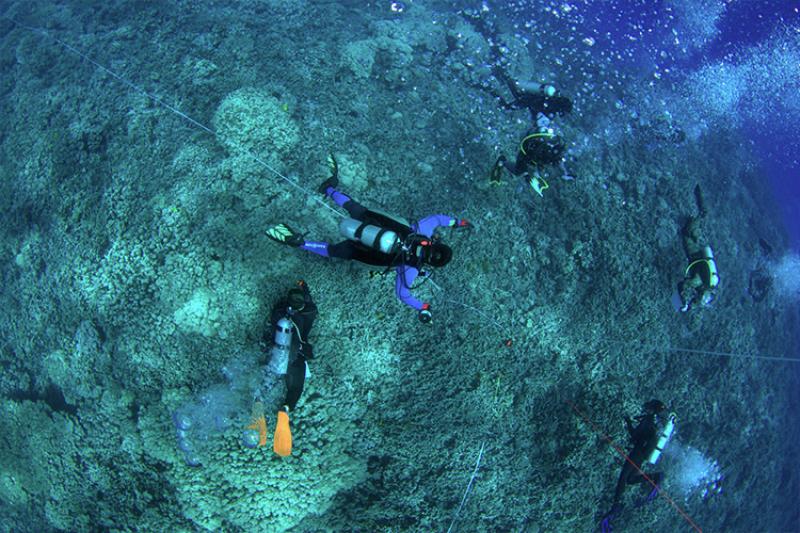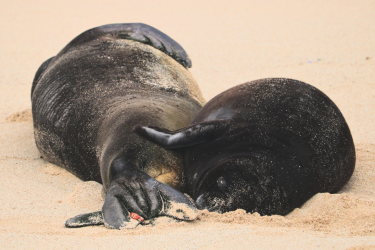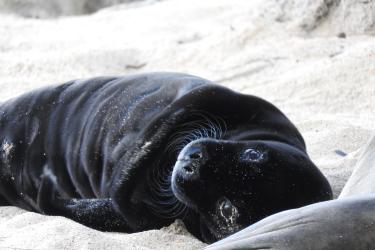The well-lit room boasts two slow cookers on a small mobile table; two deep sinks with ample counter and cabinet space; two walk-in freezers large enough to fit king-size beds; and a central, hip-high table that could easily hold multiple adult boars for roasting.
If not for the overwhelming putrid scent, the room could pass for an unfinished kitchen of a new restaurant.
"This is the worst it'll smell," Taylor Williams says as she loads small bones into the slow cookers, unphased by the stench that, at times, is a cross between manure and rotting animal flesh. "Well, the worst until the bones start boiling."
This is certainly no restaurant and Williams is no master chef concocting a new and exotic (albeit smelly) culinary masterpiece in her decked-out kitchen. Rather, the marine biology college senior is an intern with the NOAA Pacific Islands Fisheries Science Center (PIFSC) and her task is to boil the meat off of turtle humerus bones in the sea turtle necropsy (animal autopsy) lab. The gruesome work is part of a project led by Williams' mentor Shawn Murakawa to determine the age of deceased sea turtles by counting rings within the bones (similar to tree rings).
"I do all the dirty work for that project," Williams explains, adding that the other tasks of her internship include taking care of PIFSC's rehabilitating sea turtles, responding to after-hours sea turtle strandings, entering data, and conducting her own research project using the humeri.


Unlike many other certificate programs in the country, MOP is focused primarily on giving students the experiential (hands-on and out-of-the-classroom) education, scientific training and research opportunities, and extensive professional connections necessary to succeed in marine science fields. Current students and graduates of MOP are highly attractive candidates for both internships and staff positions at a wide range of organizations throughout the islands and beyond, including at NOAA.
“Upon touring the University of Hawaiʻi, I had no intention of going to UH for my undergrad,” admits California-born Williams. “But then I was introduced to MOP and that was the deciding factor for getting me to come out here.”
Despite the immense value MOP provides to both students and hiring organizations, the program has struggled to fit within the UH system, particularly at the Mānoa campus, prompting it to rely on external funding and donations to remain afloat (MOP currently has a 5-year grant from the NOAA Fisheries Pacific Islands Regional Office*). And these struggles will likely continue—that is, unless the program finds sustainable external funding or changes the structure and directives that have made it so effective and so prized in the marine science community.
What Is MOP?
Though it started with humble beginnings at UH-Mānoa, the decades-old Marine Option Program is now spread out across the state at the University of Hawaiʻi’s various campuses, with nearly 300 students enrolled.
Each campus has at least one MOP coordinator who manages the individual programs’ day-to-day activities and interfaces with students. The MOP Director—currently Dr. Cindy Hunter, associate professor of biology at UH Mānoa on Oʻahu—acts as a regional manager who’s tasked with coordinating all of the campuses.
At the Mānoa campus, MOP sees students from a range of disciplines, from business to communications to education. Sixty-five to seventy-five percent of those who come through the program are marine biology majors, explains MOP’s Mānoa coordinator and alumnus Jeff Kuwabara.
To earn the certificate, students must complete 12–16 credit hours of marine-related courses and the 1-credit MOP Seminar.
They must also complete a “skill project,” which is usually an internship or research project under the guidance of a mentor or expert in the field. However, given the eclectic mix of MOP students, the skill project takes many forms. “If they’re writers, they can go to one of the professors of poetry and do a book on ocean-related poetry, if they want,” Kuwabara says. Previous students have edited MOP’s student-run newsletter Seawords for their skill project, while others produced ocean-related art pieces, he adds.
But to say that MOP is simply a certificate program for marine science wouldn’t do it justice. For example, beyond completing MOP’s required courses and skill projects, students have the opportunity to engage in a wide range of field trips and activities, such as agency tours (including of NOAA), coastal hikes, kayaking trips, beach clean-ups, humpback whale counts, and barbecues with MOP alumni and professionals in the field.
And then there are the field courses, of which the standout is the Quantitative Underwater Ecological Surveying Techniques (QUEST) course.


Held on Hawaiʻi Island, QUEST is a three-credit, two-week summer course that teaches all of the common underwater reef surveying techniques used by professional scientific divers, effectively turning students into experienced divers qualified to work on underwater research surveys and projects. Before attending the course, students must be certified scientific divers and pass identification classes for Hawaiʻi seaweed, fish, and invertebrates—they must learn 200 species by their scientific names, spelling included. These classes are also available to agency staff seeking to brush up on their local species.
Norton Chan, a senior coral specialist with Hawaiʻi’s Division of Aquatic Resources, stresses the value of QUEST. “It teaches a lot of things that we do here at DAR, including how to do fish counts, coral counts, and transects,” says Chan, who went through MOP with Kuwabara in the early 1990s.
“It’s an insane amount of work,” Williams says of QUEST. “But it’s really fun and you meet tons of different mentors who have worked all over the world. There’s always lots of NOAA folks there, which puts you in good contact with people locally, as well as sometimes people from California or Florida.”
Other field courses available to MOP students include Maritime Archaeology Surveying Techniques, which provides hands-on training for surveying plane- and shipwrecks underwater, and the Motorboat Operator Certification Course, a NOAA training and certification course for basic boat handling that’s required for students to operate MOP-owned watercraft.
“In many ways, MOP has been cutting-edge, particularly with the hands-on activities,” Kuwabara says. “Yet, people in academia see us as a boutique program or club because the students have fun while they learn in many instances. But don’t you think that’s the way it should be?”
Vast Network, Vast Opportunities
If there’s one thing everyone can agree on, it’s the value of undergraduate internships and research experiences.
As coordinator, Kuwabara makes every effort to pair motivated students with opportunities that match their interests. “I see my role, in part, as being a facilitator between the students and either mentors or employers,” he says. “And I think I’m pretty successful in that role because I tap into my network.”
During his time in MOP, Kuwabara interned as the MOP student coordinator. And after he graduated, he worked with Hawaiʻi Sea Grant at the Hanauma Bay Education Program and then at the Mokupāpapa Discovery Center in Hilo, Hawaiʻi before returning to MOP. “I expanded my network through these jobs, but I developed a lot of my network as a MOP student and with the people I went to school with, who are now my colleagues in other agencies.”
“We have people at NOAA, UH, the U.S. Fish and Wildlife Service, Hawaiʻi Department of Land and Natural Resources, Waikīkī Aquarium, the Nature Conservancy, and many universities,” MOP Director Hunter comments about the reach of MOP’s connections. DAR’s Chan adds: “You can throw a dart anywhere in this field [in Hawaiʻi]and where it lands, you’ll find someone who has gone through MOP or is associated with it somehow.”
What this all boils down to is a vast array of opportunities available to students.
For instance, some students get research experience through various connections in the university system, such as at the Hixon Lab at UH Mānoa or the Gates and ToBo Labs at the Hawaiʻi Institute of Marine Biology. Alternatively, students interested in education may choose to intern in the education department of the Waikīkī Aquarium (as did Williams before coming to NOAA) or at Our Project in Hawaiʻi’s Intertidal (known as OPIHI), a program out of the UH College of Education that trains young students how to survey and monitor intertidal and coastal environments.
Like his classmate Williams, MOP student Jake Reichard has taken full advantage of these opportunities, having worked with UH marine ecologist and MOP alumnus Kosta Stamoulis, as well as the Hixon Lab. He has also participated in NOAA’s 2018 Pacific Reef Assessment and Monitoring Program cruise, which is open to MOP students who have gone through QUEST—though selection is highly competitive, as there are only a few slots open for students. This cruise introduced him to a seasoned, expeditious style of diving.

“With NOAA, we would just roll off the boat and get straight to diving instead of stopping first,” says Washington native Reichard, a certified scuba diver since age 12. “That was fun.”
Reichard has just completed an internship under Chan and Chelsea Wolke, another MOP alumna, at DAR’s Coral Restoration Nursery, which is focused on mitigating damage to corals during harbor construction projects. Before such projects begin, nursery staff collect native corals from the harbor, grow them in the nursery, and then outplant the corals back onto reefs. This work ensures there is no net loss of coral reefs from the construction projects.
The internship has solidified Reichard’s love of coral reefs and he is now moving on to another internship with the Monterey Bay Aquarium. “I’ve always been interested in aquarium work but I didn’t know if I could do it,” he says. “I’ve had a great time here and that’s why I’m applying for aquarium jobs now.”
This notion of students finding or cementing their passions through their MOP experiences is not uncommon. One case in point is Chad Yoshinaga, another classmate of Kuwabara. During his time with MOP, Yoshinaga held research positions with NOAA and an internship with the agency to do fieldwork at Laysan Island in the Northwestern Hawaiian Islands.
“It was through MOP that I got the opportunity to go and do fieldwork, which then led to my full time position with NOAA,” says Yoshinaga, who is now team lead for PIFSC’s science operations division. “I owe MOP a lot for my career.”
Keys to Success
Just as students gain much from MOP, so does the local scientific and conservation community.
“These are highly trained and specially trained, highly vetted, self-motivated individuals who are the top contenders for agency positions in fisheries- and marine-related work,” Hunter says.
That aforementioned motivation is a key to success, Yoshinaga adds. “Aside from the obvious experience and educational opportunities, what MOP really did was it showed me that my effort to be involved and get involved paid off dividends,” he says. “If I put effort into something, I would reap the rewards."

With the skills and mindset the program instills into its students, it’s no surprise that MOP alumni currently hold top positions in federal agencies in the Pacific, including at the NOAA Fisheries Pacific Islands Regional Office (Regional Administrator Michael Tosatto) and the Papahānaumokuākea Marine National Monument (Superintendent Athline Clark and Deputy Superintendent Randy Kosaki). “NOAA funds the program because of the outcome and quality of the students and alumni, who highly fit into positions that benefit NOAA,” Hunter suggests.
It is perhaps ironic, then, that the very qualities of the program that make it worthy of external funding also make it reliant on such funding.
While the coursework is important for personal development, Hunter and Kuwabara don’t force the work onto the students. The students instead take what they need from the program, which often ends up being the optional field courses, extracurricular activities and networking benefits, MOP study center (which, to some, is a kind of second home), and internship and research opportunities.
For many students, the coursework is too much to fit into their packed college workload, forcing them to attend school for an extra semester, which may be financially unfeasible. “There are only about 10 students that complete their certificates each year,” Hunter says frankly.
With only 10 or so certificate completions a year, MOP is a hard sell to the university administration for funding. “But MOP influences 10 times as many students as the certificates show,” Hunter argues. Kuwabara adds: “And that’s hard to measure—how do you show that to the administration?”
So MOP instead leans heavily on the generosity of others, whether it’s NOAA, alumni, students’ parents, or unexpected donors like the Wallenberg Foundation. These external funds have helped keep MOP alive, but not without sacrifices. A prime example: MOP had to cut a special program that trains non-students who want to become observers on longline fisheries but don’t have the bachelor’s degree prerequisite (this program was especially beneficial to people in U.S. Pacific Island territories, such as Guam and Saipan).
Current students, however, are grateful for the wealth of opportunities MOP still provides. “I’ve no regrets coming to Hawaiʻi,” says Reichard, who not only completed the certificate requirements to help justify MOP’s continuation at UH but also uses every opportunity to promote the program to both current and prospective university students. "I’ve had a blast here."

Back in the smelly, well-equipped, not-quite-a-kitchen necropsy lab, Williams explains that, unlike Reichard who long had his eyes set on UH Mānoa, her top school was back in her home state but she ultimately moved to Hawaiʻi for MOP. And while she’s accomplished much during her time in the program, she notes that there’s still much to do before she graduates at the end of the year: She’ll be going through MOP’s maritime archaeology field course in the summer, she hopes to join NOAA’s field camp in the Northwestern Hawaiian Islands in the fall to help monitor sea turtle nesting, and she still has more sea turtles to save and lots more bones to boil in her NOAA internship.
When asked if she made the right choice with MOP, Williams responds enthusiastically, “Yes, yes, oh my gosh, yes!”
*Funding is through the Marine Education and Training Grant program distributed regionally through the NOAA Fisheries Pacific Islands Regional Office. These grants help increase the sustainability, viability, and visibility of fishing and marine resource issues by improving communication, education, and training on marine resources. Funded projects prepare communities for employment in marine-related professions; increase seafood and fishing safety, marketing, or management; and increase the sustainability of fishing practices through technology improvements or data collection. All projects are developed with and include partnerships that contribute to the success of the project and build on or expand relationships in the fishing and marine community.




